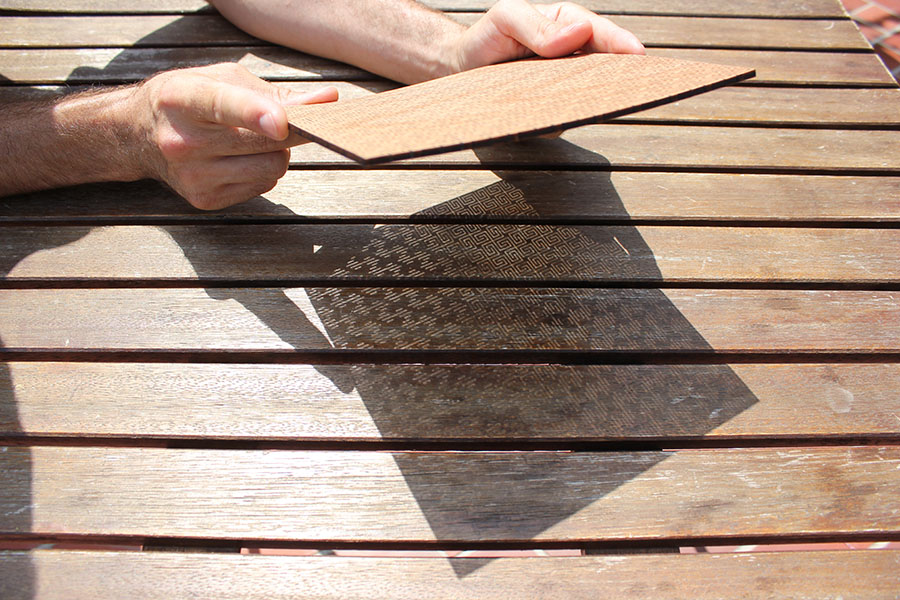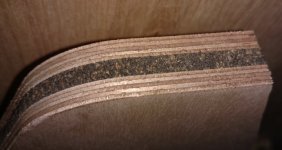Yeah 3mm (1/8") sheets glued two sheets at a time. Sheets are about 15mm larger in length and width than they need to be to allow for some misalignment during gluing. They are flush trimmed with a router table.

I made a skeleton jig with the inverse profile of the box so I could clamp it evenly. In a previous project I used ratchet straps to clamp but that was problematic as they also clamped the panels in the front-to-rear direction making them want to bow out in the middle, so I had to add various other clamps in a juggling act to get everything to sit right while the glue dried.

I made a skeleton jig with the inverse profile of the box so I could clamp it evenly. In a previous project I used ratchet straps to clamp but that was problematic as they also clamped the panels in the front-to-rear direction making them want to bow out in the middle, so I had to add various other clamps in a juggling act to get everything to sit right while the glue dried.
Last edited:
10F/8424 & RS225-8 FAST / WAW Ref Monitor
by xrk971
by xrk971
10F/8424 & RS225-8 FAST / WAW Ref MonitorTo answer your question if I have measured the difference between XPS foam cabinet vs an all BB ply cabinet treated with butyl rubber dampening sheets and eggcrate foam, yes. The data you want to look at is the harmonic distortion plot vs frequency.
Without
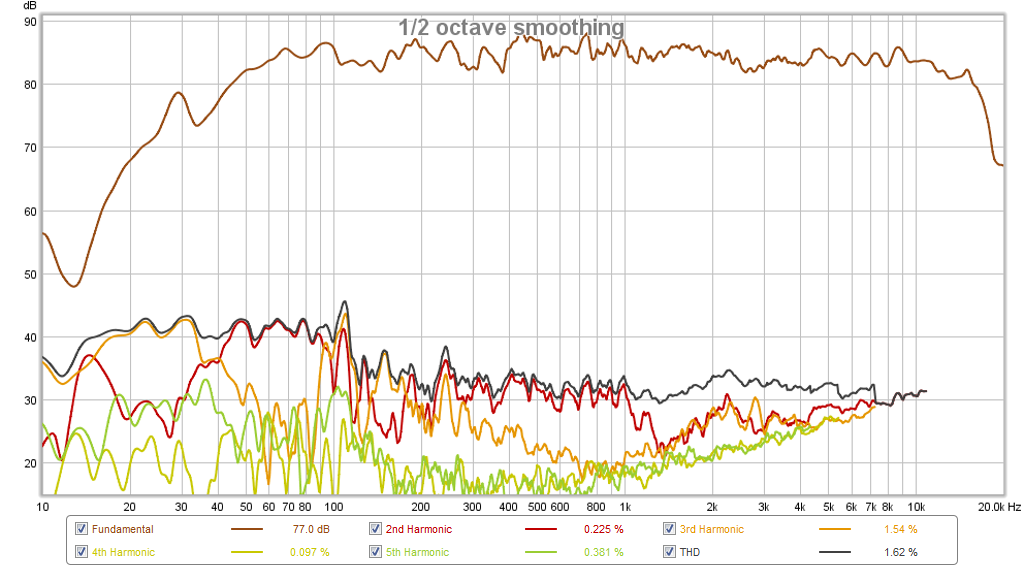
Dampening and eggcrate foam
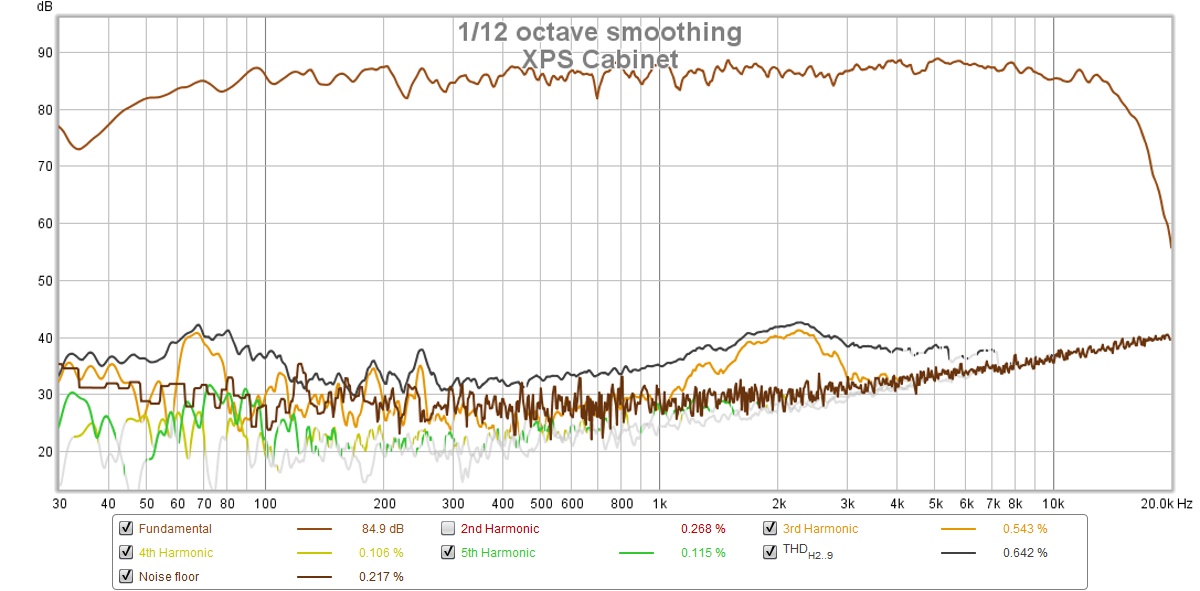
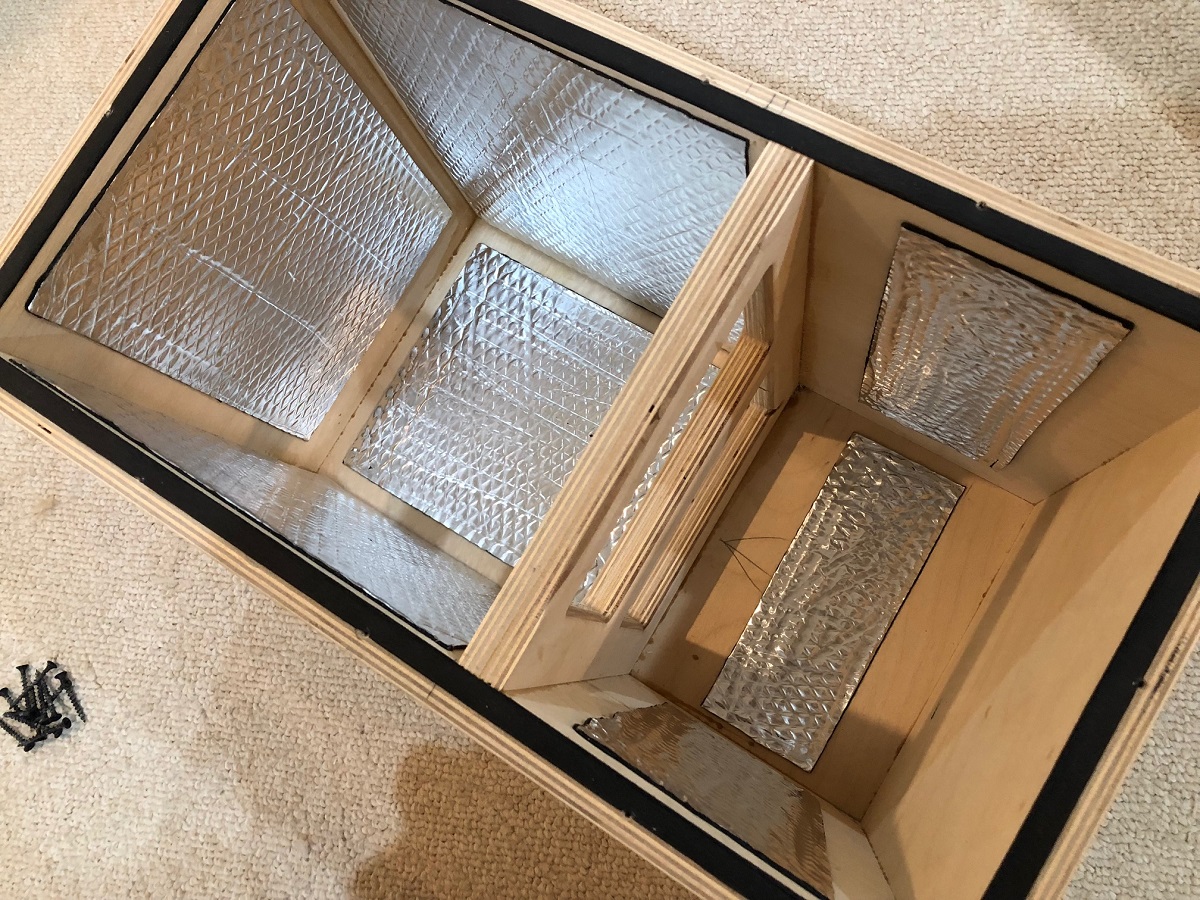
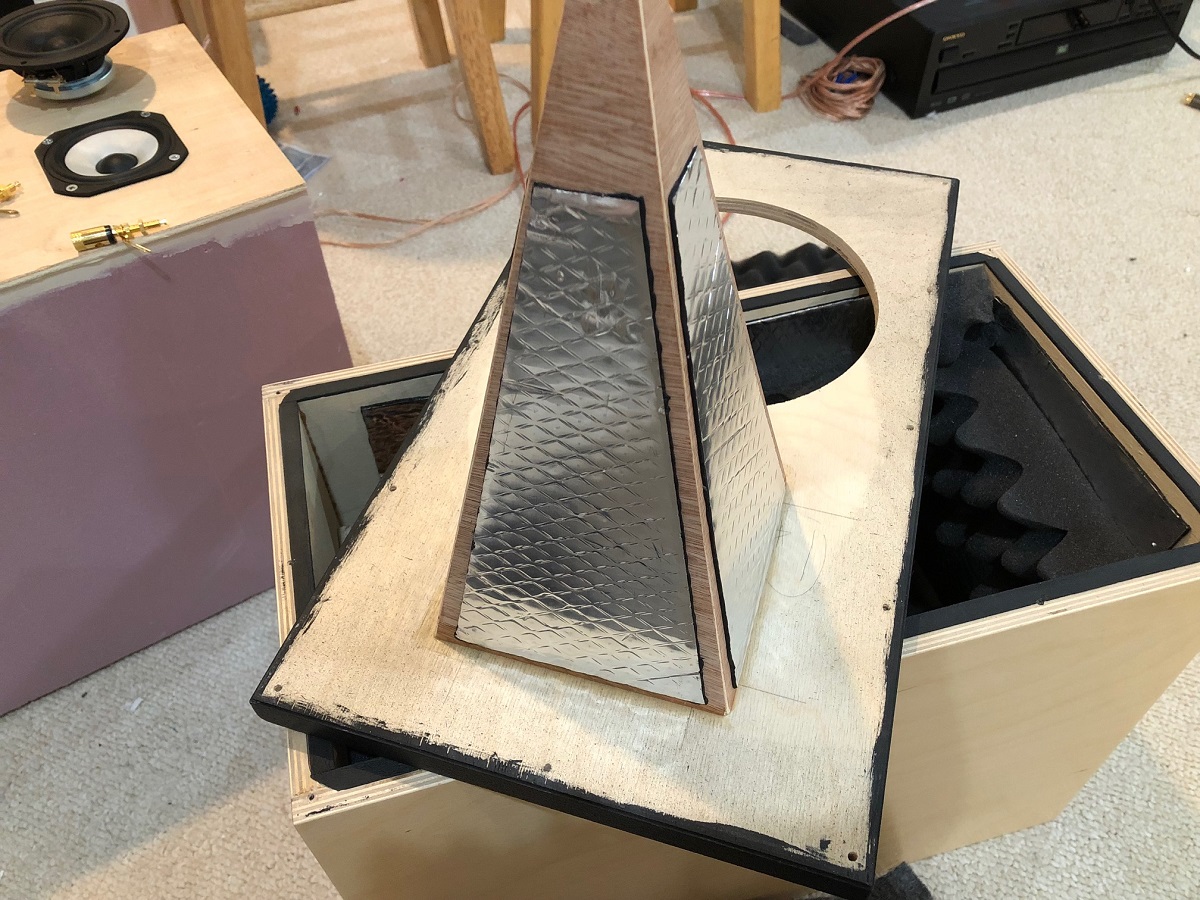
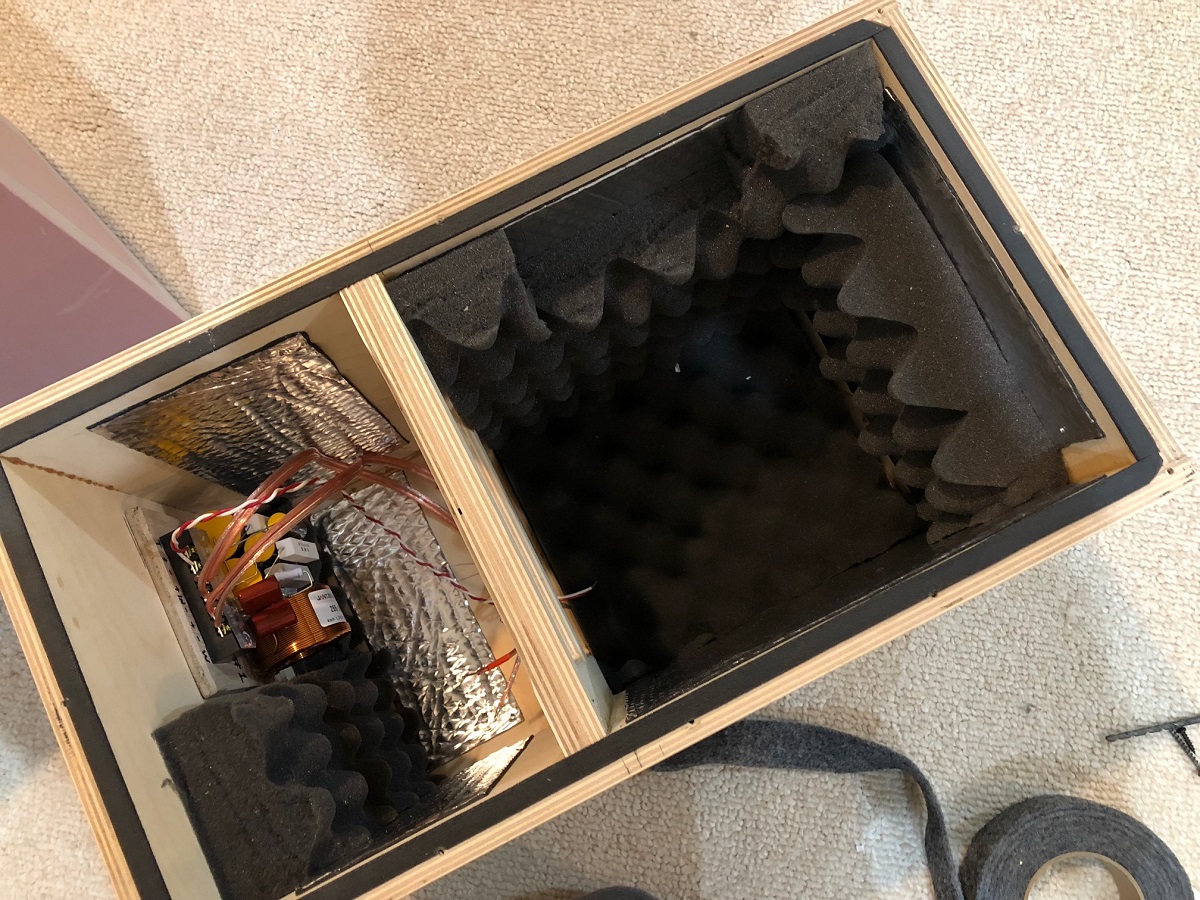
Default 10F/8424 & RS225-8 FAST / WAW Ref Monitor
...I wanted a speaker design worthy of the exceptionally high performing ScanSpeak 10F/8424 Discovery 3.5in full range driver. I decided that a short sealed Dagger TL coupled with a sealed bass unit would give me the best overall transient response and clarity. I decided to mate the 10F/8424 with the superb Dayton RS225-8 aluminum cone woofer for bass duties. The design ended up as a 24 liter volume for the woofer and a 1.1 liter 3-sided pyramid Dagger for the 10F/8424. The important external dimensions are: 10in wide baffle and 24 liter internal volume (sealed)...
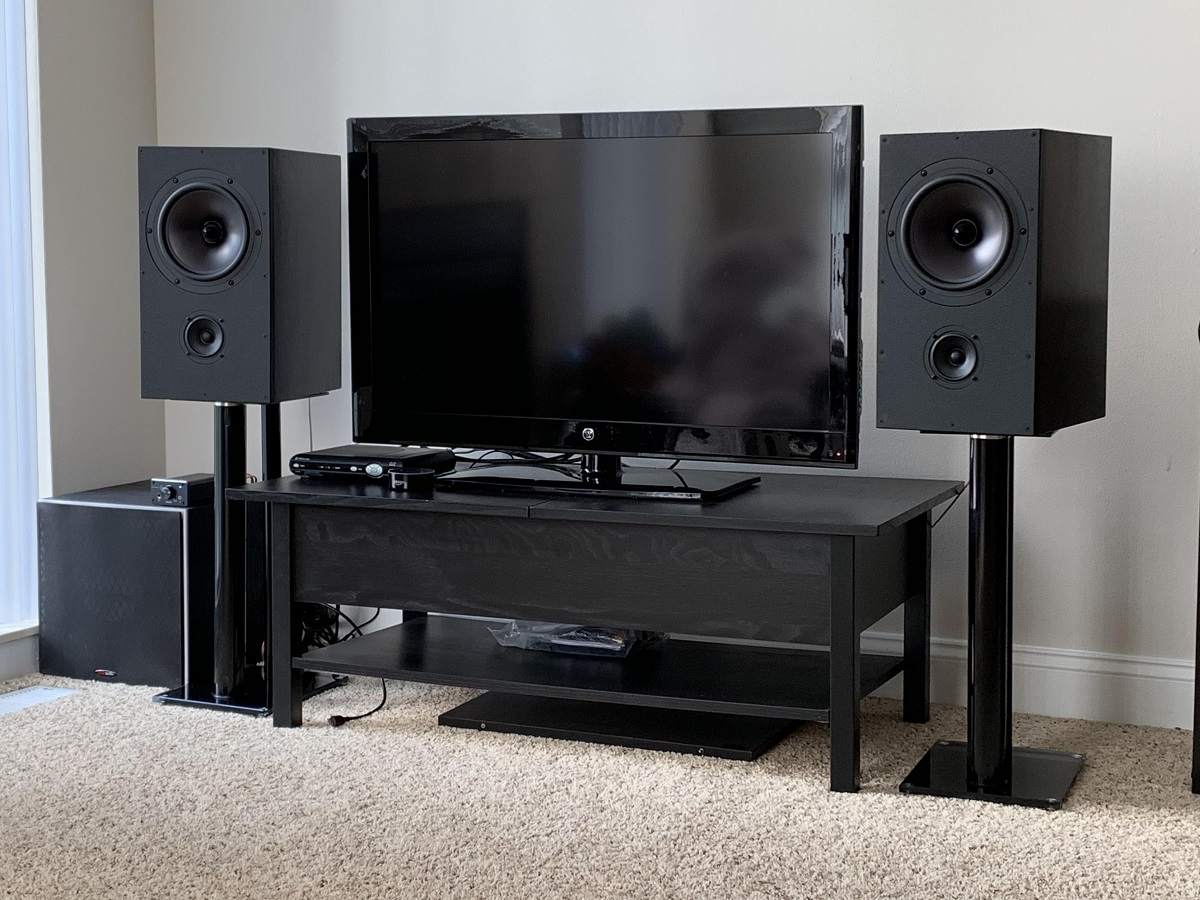
Last edited:
People tend to think of plywood as stiiff and solid and a thing with its own properites... but it's just made up of thin veneers that people decided to glue together flat.
That sounds an obvious thing to say... but people don't think about how they can make their own plywoood from veneers in non-flat shapes without having all the problems of re-shaping something that was made flat.
How bendy is 3mm birch ply? Could you get the same curve as the MDF above? That would save a few layers of gluing.
And of course, you can apply that to other materials or combinations of materials to get the properties you want.
Acoustic properties, for example with holes in each layer to create a surface that might change airflow or reflections. Or holes to be filled with something, like damping goo.
Get yourself a CNC laser cutter and shape those pieces of ply by machine, including super-flexible shapes: Super flexible laser cut plywood | koFAKTORlab
That sounds an obvious thing to say... but people don't think about how they can make their own plywoood from veneers in non-flat shapes without having all the problems of re-shaping something that was made flat.
How bendy is 3mm birch ply? Could you get the same curve as the MDF above? That would save a few layers of gluing.
And of course, you can apply that to other materials or combinations of materials to get the properties you want.
Acoustic properties, for example with holes in each layer to create a surface that might change airflow or reflections. Or holes to be filled with something, like damping goo.
Get yourself a CNC laser cutter and shape those pieces of ply by machine, including super-flexible shapes: Super flexible laser cut plywood | koFAKTORlab
Last edited:
People tend to think of plywood as stiiff and solid and a thing with its own properites... but it's just made up of thin veneers that people decided to glue together flat.
The material that the veneers are made of, how they are oriented (if they have a (grain) direction), how thick, how many plies, the glue used all affect the properties.
One of my gurus made his own plywood of real thin HDF (7 plies?) with a 10 ton press. The 5 ply cheap mdf plywood sides of the curved cabs they used to sell was better than the solid mdf ones. The Murphy Ply (baltic cores with NA maple veneers) was decidedly better than the BB we had been using.
Bamboo plywoods i am familiar with have ~3mm veneers sandwiching a block core. There are 3 diffirent veneer constructions with considerably different properties.
… how they can make their own plywoood from veneers in non-flat shapes without having all the problems of re-shaping something that was made flat.
Somewhere, somewhere out on the web there is an illustrated example of making the curved parts of a hedlund horn this way, and B&W has a video of the giant machine they have in Denmark that takes many sheets of veneer and presses them into the 32mm thick Nautilus series curved bass cabinets. I’m sure more could be found.
How bendy is 3mm birch ply?
3mm ply is likely going to be 3 1mm plies with the middle one’s grain oriented perpendicular to the other 2. This resists bending. The one Chris build ended up burning. But if you glue 3 1mm veeners together easily.
We had success with a double layer of special purpose bendy plywood (shaped on a form in a vacuum bag) over a plywood matrix frame, veneer over that. It works well.
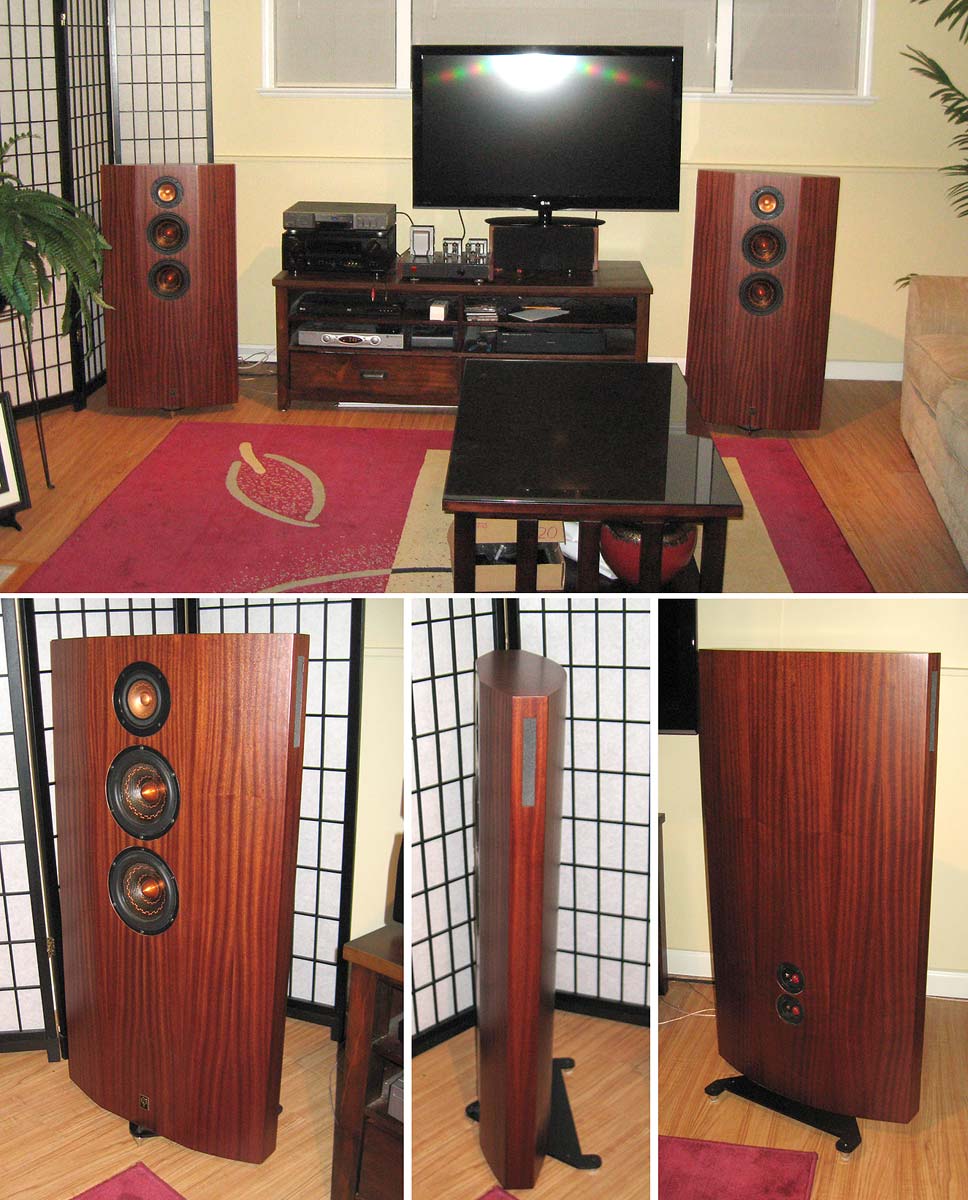
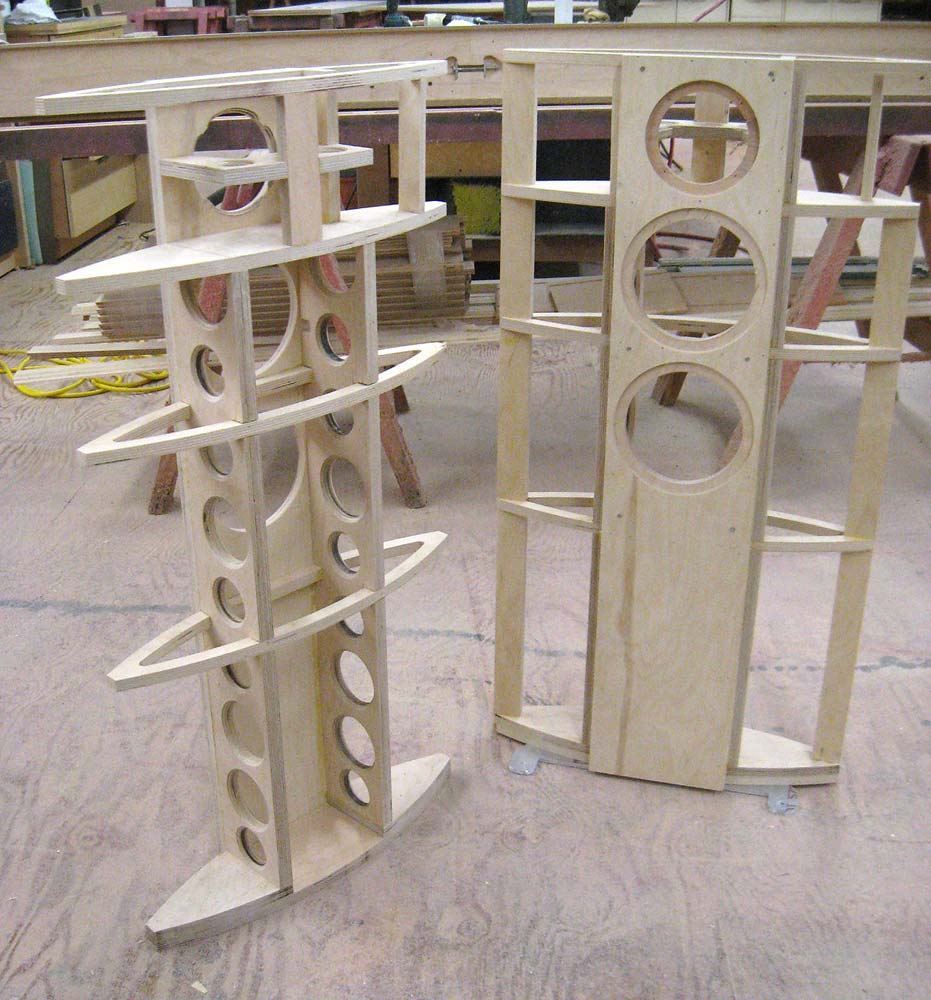
And of course, you can apply that to other materials or combinations of materials to get the properties you want.
There is a lot to explore there. Take the veneer layer of the stranded bamboo plywood and use 3 of those between 2 outer veneers (alternating grain) — the veneers are available, you’d just need the 10-ton press and figure out the best glue (different ones for different aps?)
dave
Another application of laser-cut ply would be to make a cabinet that had frequency variable pressure properties (physical impedances ?) by creating air gaps
The rectangular spiral referred to in your link is the shape of the classic Greek Key motif. Glad to see there are interesting and modern uses for it.
Last edited:
There is a lot to explore there. Take the veneer layer of the stranded bamboo plywood and use 3 of those between 2 outer veneers (alternating grain) — the veneers are available, you’d just need the 10-ton press and figure out the best glue (different ones for different aps?)
dave
A vacuum bag will apply all the pressure you need but I'm sure you already know that. Presses and molds are great for production but that's usually not how the prototypes are made. I've never used bamboo plywood before but raw bamboo has a lot of waxy oils that have to be dealt with before glue will stick to it so you might be right about the glue
I've built free hanging radius stair case stringers on site by laminating rips of 3/16" lauan into 6" thick beams.
You can buy special bendy plywood in various thicknesses.
I've also found a plywood manufacturer where you can specify what your ply is made of including sound deadening layers which is usually used for boat building.
Never even dared to ask for prices or minimum order size though.
I've also found a plywood manufacturer where you can specify what your ply is made of including sound deadening layers which is usually used for boat building.
Never even dared to ask for prices or minimum order size though.
A vacuum bag will apply all the pressure you need but I'm sure you already know that.
If I'm not mistaken, 10 tons applied to a 4' x 8' sheet is a bit over 4 psi.
I've also found a plywood manufacturer where you can specify what your ply is made of including sound deadening layers which is usually used for boat building.
A friend who works at a supplier for custom marine panels brought me some leftovers, enough for two modest baffles.
5 Ply x 2 with a urethane?/cork damping layer:
Attachments
If I'm not mistaken, 10 tons applied to a 4' x 8' sheet is a bit over 4 psi.
A friend who works at a supplier for custom marine panels brought me some leftovers, enough for two modest baffles.
5 Ply x 2 with a urethane?/cork damping layer:
That looks fantastic for our application- make a frame for the interior box and let the outside panels float (so no connection to each other, you'd see the cork layer)
That's the plan, badman- driver mounted to the outside layer of ply, and the cork layer doubles as decorative.
If you can, I'd try to mount it to the inside and shape the wood in front- the idea being the excitation excites the inner panel and has to pass through the CLD to emit panel resonance into the room.
I have commented on it in other forums (ASR), but I think it should be here too.
KEF R&DR Series 2018
[PDF] https://us.kef.com/pub/media/documents/rseries/rseries2018-white-paper.pdf
[ There are two common ways of reducing panel output:
• Adding bracing between the panels to increase stiffness.
• Adding damping pads to the panels.
...KEF Engineers developed a technique, originally for the LS50 loudspeaker system but applied to all R Series 2018 systems, that combines the two approaches and is more effective than both. The technique, called damped bracing, consists of strategically placed wooden braces that, instead of being rigidly coupled to the panels are joined via a lossy interface. The braces are placed where the panel movement would otherwise be greatest and the lossy layer, like normal damping pads, converts the energy into heat.
Additional damped braces are situated at the back of each driver, which reduce the level of reactionary vibration transmitted from the driver to the cabinet.

The reduction in sound output from the cabinet varies model by model, depending on the exact geometry, but is typically of the order of 20dB, as shown in figure 3.
Cabinet sound radiation is highly distorted and, at the resonance frequencies, causes time-smearing as the output hangs on. The increase in clarity wrought by the damped bracing is readily noticeable, is probably best in class for single-enclosure multi-way loudspeaker systems and is comparable to the best high-end systems ]
KEF R&DR Series 2018
[PDF] https://us.kef.com/pub/media/documents/rseries/rseries2018-white-paper.pdf
[ There are two common ways of reducing panel output:
• Adding bracing between the panels to increase stiffness.
• Adding damping pads to the panels.
...KEF Engineers developed a technique, originally for the LS50 loudspeaker system but applied to all R Series 2018 systems, that combines the two approaches and is more effective than both. The technique, called damped bracing, consists of strategically placed wooden braces that, instead of being rigidly coupled to the panels are joined via a lossy interface. The braces are placed where the panel movement would otherwise be greatest and the lossy layer, like normal damping pads, converts the energy into heat.
Additional damped braces are situated at the back of each driver, which reduce the level of reactionary vibration transmitted from the driver to the cabinet.
The reduction in sound output from the cabinet varies model by model, depending on the exact geometry, but is typically of the order of 20dB, as shown in figure 3.
Cabinet sound radiation is highly distorted and, at the resonance frequencies, causes time-smearing as the output hangs on. The increase in clarity wrought by the damped bracing is readily noticeable, is probably best in class for single-enclosure multi-way loudspeaker systems and is comparable to the best high-end systems ]
Betcha that KEF's engineers were asked, "How can we make the cheapest cabinet that doesn't seem like garbage when customers knock on it in the stores?" And secondarily, "...something please with a fancy description that we can sneak past the patent office clerks".
Ever the way in the world of commerce.
BTW, is KEF - like always in this discussion - demonstrating wall vibration, not audible effects?
And the comparison I'd like to see is between a reasonably-made cab and the KEF box. That's the criterion.
B.
Ever the way in the world of commerce.
BTW, is KEF - like always in this discussion - demonstrating wall vibration, not audible effects?
And the comparison I'd like to see is between a reasonably-made cab and the KEF box. That's the criterion.
B.
Last edited:
Just some thoughts of mine, call it my 2 cents.
Straight beams is great for supporting a house standing on solid bedrock.
With the possibility of earthquakes they sometimes add an elastic dampener for the shear stress and not so much the bouncing (wide but not thick).
In constructions with equal properties (strength or weight) on both sides, like a roll cage in a racing car, they never attache a brace perpendicular as that would buckle instead of introducing shear stress.
So I'm not really convinced about the design from KEF, it might be better than nothing, but seems implemented wrong, or for mass-production.
I did built a subwoofer-box recently using triangular braces attached at points that was also different from each other (different size panels and/or different distance to edges), and it worked really well.
I do have some new ideas to test though, as usual, but I will be using the same basics of directing the forces in planes where the strength or weight is.
Straight beams is great for supporting a house standing on solid bedrock.
With the possibility of earthquakes they sometimes add an elastic dampener for the shear stress and not so much the bouncing (wide but not thick).
In constructions with equal properties (strength or weight) on both sides, like a roll cage in a racing car, they never attache a brace perpendicular as that would buckle instead of introducing shear stress.
So I'm not really convinced about the design from KEF, it might be better than nothing, but seems implemented wrong, or for mass-production.
I did built a subwoofer-box recently using triangular braces attached at points that was also different from each other (different size panels and/or different distance to edges), and it worked really well.
I do have some new ideas to test though, as usual, but I will be using the same basics of directing the forces in planes where the strength or weight is.
And the comparison I'd like to see is between a reasonably-made cab and the KEF box. That's the criterion.
I agree. It is too easy to set up a straw-man example to show that someone's preferred cabinet method is superior. Compared to a thin-walled chipboard box with no bracing, ANY reasonable cabinet construction technique is going to be better.
30 years as an aircraft structural engineer, dealing with both static loads and dynamic loads (i.e. vibration loads), leads me to believe in the high stiffness approach to cabinet construction. Planet10 has described what I feel is a reasonable and easily executed approach to crafting a cabinet: Use a stiff but readilly available material ( 19 mm baltic birch plywood), and use lots of bracing to divide the 6 panels into high aspect ratio smaller panels. This makes sense to me.
Front: 36 mm MDF. Sides: 19 mm HDF
Minutes ago, in ASR, I have published the specs and more info of Tannoy System 600, old studio monitors.
Tannoy System 600 Speaker Review | Page 3 | Audio Science Review (ASR) Forum

36 mm MDF and 19 mm HDF!
The waves transmission is reduced by using different materials with different densities and thicknesses, as Tannoy knows.
To spend money, ALL MDF but the front thicker. Bracing + viscoelastic material.
...Planet10 has described what I feel is a reasonable and easily executed approach to crafting a cabinet: Use a stiff but readilly available material (19 mm baltic birch plywood), and use lots of bracing to divide the 6 panels into high aspect ratio smaller panels. This makes sense to me.
Minutes ago, in ASR, I have published the specs and more info of Tannoy System 600, old studio monitors.
Tannoy System 600 Speaker Review | Page 3 | Audio Science Review (ASR) Forum
36 mm MDF and 19 mm HDF!
The waves transmission is reduced by using different materials with different densities and thicknesses, as Tannoy knows.
To spend money, ALL MDF but the front thicker. Bracing + viscoelastic material.
Last edited:
- Status
- This old topic is closed. If you want to reopen this topic, contact a moderator using the "Report Post" button.
- Home
- Loudspeakers
- Multi-Way
- Is MDF or plywood better for speaker cabinets?
